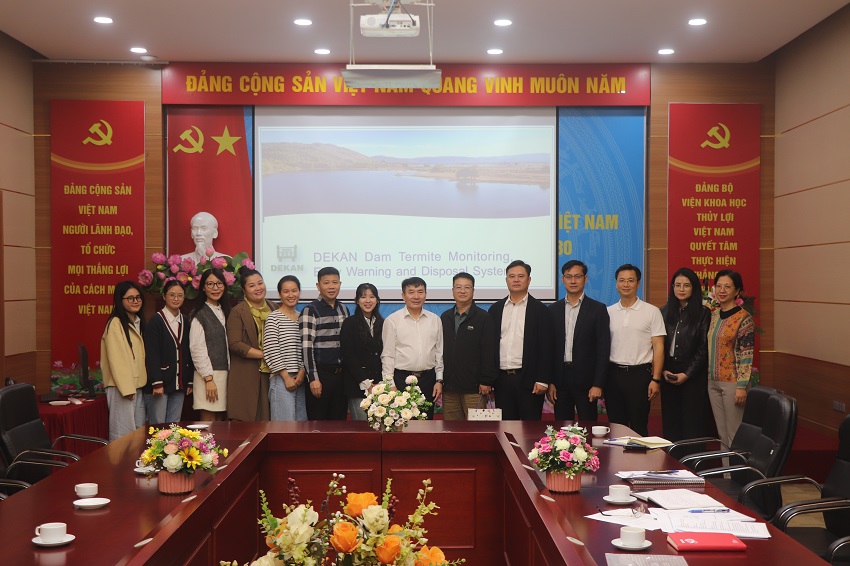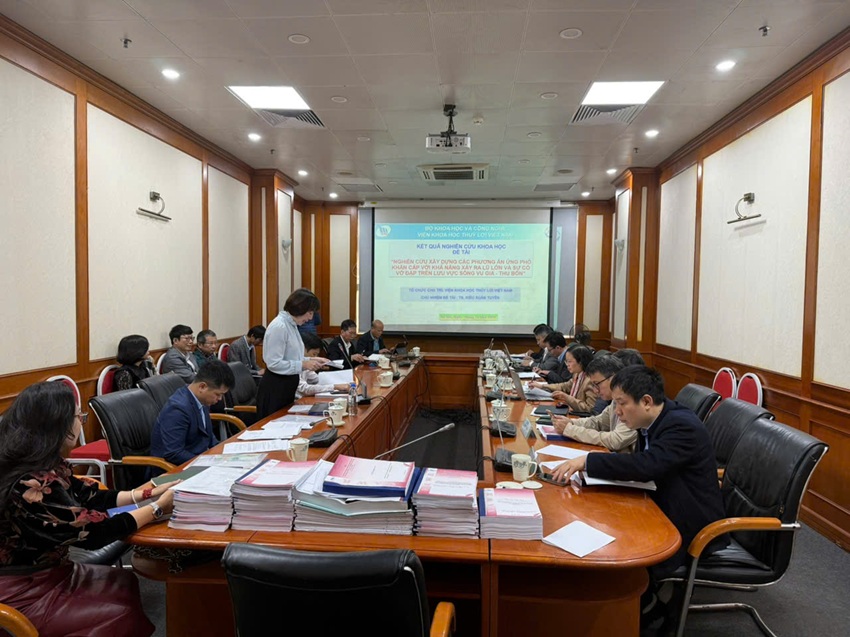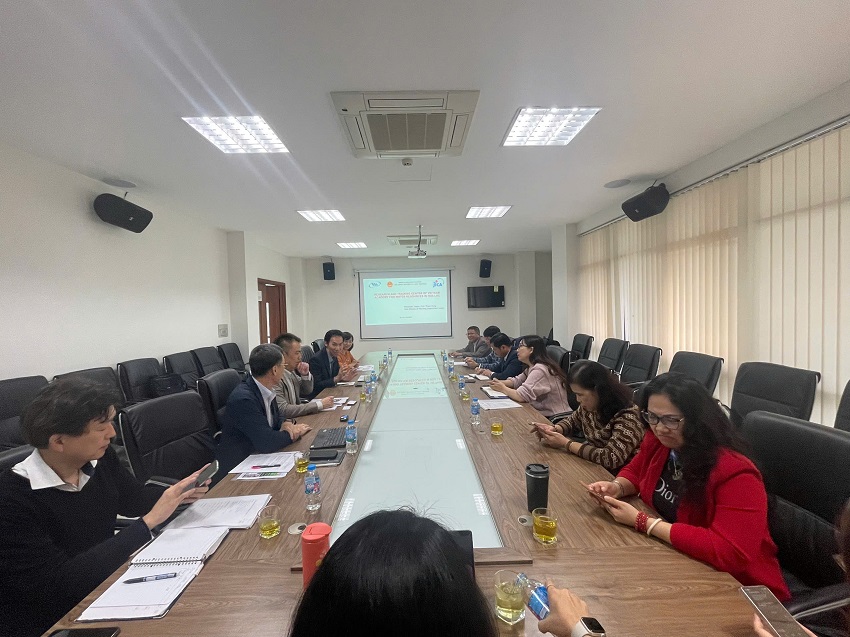Assessment of Flood Extremes Using Downscaled CMIP5 High-Resolution Ensemble Projections of Near-Term Climate for the Upper Thu Bon Catchment in Vietnam
22/10/2021Exploring potential floods is both essential and critical to making informed decisions for adaptation options at a river basin scale. The present study investigates changes in flood extremes in the future using downscaled CMIP5 (Coupled Model Intercomparison Project—Phase 5) high-resolution ensemble projections of near-term climate for the Upper Thu Bon catchment in Vietnam. Model bias correction techniques are utilized to improve the daily rainfall simulated by the multi-model climate experiments. The corrected rainfall is then used to drive a calibrated supper-tank model for runoff simulations. The flood extremes are analyzed based on the Gumbel extreme value distribution and simulation of design hydrograph methods. Results show that the former method indicates almost no changes in the flood extremes in the future compared to the baseline climate.
However, the later method explores increases (approximately 20%) in the peaks of very extreme events in the future climate, especially, the flood peak of a 50-year return period tends to exceed the flood peak of a 100-year return period of the baseline climate. Meanwhile, the peaks of shorter return period floods (e.g., 10-year) are projected with a very slight change. Model physical parameterization schemes and spatial resolution seem to cause larger uncertainties; while different model runs show less sensitivity to the future projections.
1. Introduction
2. Materials and Methods
2.1. Description of the Study Area
2.2. Hydro-Meteorological Data
2.3. CMIP5 High-Resolution Climate Model Experiments
2.4. Model Bias Correction
2.5. Hydrological Simulation
2.6. Flood Frequency Analysis
2.7. Design Hyetograph/Hydrograph
2.8. Estimate of Confidence Interval
3. Results and Discussion
3.1. Corrected Rainfall
3.2. Simulated Discharge
3.3. Change in Flood Extremes
3.4. Design Storm Hydrographs
4. Conclusions
References
1. Hirabayashi, Y.; Mahendran, R.; Koirala, S.; Konoshima, L.; Yamazaki, D.;Watanabe, S.; Kim, H.; Kanae, S. Global flood risk under climate change. Nat. Clim. Chang. 2013, 3, 816–821. [CrossRef]
2. Wilby, R.L.; Beven, K.J.; Reynard, N.S. Climate change and fluvial flood risk in the UK: More or the same. Hydrol. Process. 2008, 22, 2511–2523. [CrossRef]
3. Milly, P.C.D.; Wetherald, R.T.; Dunne, K.A.; Delworth, T.L. Increasing risk of great floods in a changing climate. Nature 2002, 415, 514–517. [CrossRef]
4. Ulbrich, U.; Brucher, T.; Fink, A.H.; Leckebusch, G.C.; Kruger, A.; Pinto, J.G. The central European floods of August 2002: Part 1—Rainfall periods and flood development. Weather 2003, 58, 371–377. [CrossRef]
5. Fowler, A.M.; Hennessy, K.J. Potential impacts of global warming on the frequency and magnitude of heavy precipitation. Nat. Hazards 1995, 11, 283–303. [CrossRef]
6. Prudhomme, C.; Reynard, N.; Crooks, S. Downscaling of global climate models for flood frequency analysis: Where are we now? Hydrol. Process. 2002, 16, 1137–1150. [CrossRef]
7. Ekstro¨m, M.; Fowler, H.J.; Kilsby, C.G.; Jones, P.D. New estimates of future changes in extreme rainfall across the UK using regional climate model integrations. 2. Future estimates and use in impact studies. J. Hydrol. 2005, 300, 212–233. [CrossRef]
8. Kay, A.L.; Jones, R.G.; Reynard, N.S. RCM rainfall for UK flood frequency estimation. II. Climate change results. J. Hydrol. 2006, 318, 163–172. [CrossRef]
9. IPCC (Intergovernmental Panel on Climate Change). Climate Change 2007: The Physical Science Basis; Cambridge University Press: Cambridge, UK; New York, NY, USA, 2007.
10. IPCC (Intergovernmental Panel on Climate Change). Climate Change 2013: The Physical Science Basis; Cambridge University Press: Cambridge, UK; New York, NY, USA, 2013.
11. Kharin, V.V.; Zwiers, F.W.; Zhang, X.; Hegerl, G.C. Changes in temperature and rainfall extremes in the IPCC ensemble of global coupled model simulations. J. Clim. 2007, 20, 1419–1444. [CrossRef]
12. Vidal, J.P.;Wade, S.D. Multimodel projections of catchment-scale precipitation regime. J. Hydrol. 2008, 353, 143–158. [CrossRef]
13. Koirala, S.; Hirabayashi, Y.; Mahendran, R.; Kanae, S. Global assessment of agreement among streamflow projections using CMIP5 model outputs. Environ. Res. Lett. 2014. [CrossRef]
14. Alfieri, L.; Burek, P.; Feyen, L.; Forzieri, G. Global warming increases the frequency of river floods in Europe. Hydrol. Earth Syst. Sci. 2015, 19, 2247–2260. [CrossRef]
15. Dankers, R.; Feyen, L. Climate change impact on flood hazard in Europe: An assessment based on high-resolution climate simulations. J. Geophys. Res. 2008, 113, D19105. [CrossRef]
16. Nam, D.H.; Udo, K.; Mano, A. Assessment of future flood intensification in Central Vietnam using a super-high-resolution climate model output. J. Water Clim. Chang. 2013, 4, 373–389. [CrossRef]
17. Kitoh, A.; Ose, T.; Kurihara, K.; Kusunoki, S.; Sugi, M. Projection of changes in future weather extremes using super-high-resolution global and regional atmospheric models in the KAKUSHIN program: Results of preliminary experiments. Hydrol. Res. Lett. 2009, 3, 49–53. [CrossRef]
18. Toan, D.D.; Tachikawa, Y.; Shiiba, M.; Yorozu, K. River discharge projection in Indochina Peninsula under a changing climate using the MRI-AGCM3.2S dataset. Ann. J. Hydraul. Eng. 2013, 69, 37–42.
19. Prudhomme, C.; Jakob, D.; Svensson, C. Uncertainty and climate change impact on the flood regime of small UK catchments. J. Hydrol. 2003, 277, 1–23. [CrossRef]
20. Nam, D.H.; Duong, P.C.; Thuan, D.H.; Mai, D.T.; Dung, N.Q. Near-term runoff response at a river basin scale in Central Vietnam assessed using direct CMIP5 high-resolution model outputs. Water 2018, 10, 477. [CrossRef]
21. Kay, A.L.; Davies, H.N.; Bell, V.A.; Jones, R.G. Comparison of uncertainty sources for climate change impacts: Flood frequency in England. Clim. Chang. 2009, 92, 41–63. [CrossRef]
22. Fowler, H.J.; Blenkinsop, S.; Tebaldi, C. Linking climate change modelling to impacts studies: Recent advances in downscaling techniques for hydrological modelling. Int. J. Climatol. 2007, 27, 1547–1578. [CrossRef]
23. Allan, R.P.; Soden, B.J. Atmospheric warming and the amplification of precipitation extremes. Science 2008, 321, 1481–1484. [CrossRef] [PubMed]
24. Palmer, T.N.; Raisanen, J. Quantifying the risk of extreme seasonal precipitation events in a changing climate. Nature 2002, 415, 512–514. [CrossRef]
25. Scher, S.; Haarsma, R.J.; de Vries, H.; Drijfhout, S.S.; van Delden, A.J. Resolution dependence of extreme precipitation and deep convection over the Gulf Stream. J. Adv. Model. Earth Syst. 2017, 9, 1186–1194. [CrossRef]
26. Oouchi, K.; Yoshimura, J.; Yoshimura, H.; Mizuta, R.; Kusunoki, S.; Noda, A. Tropical cyclone climatology in a global-warming climate as simulated in a 20 km-mesh global atmospheric model: Frequency and wind intensity analysis. J. Meteorol. Soc. Jpn. 2006, 84, 259–276. [CrossRef]
27. Wehner, M.F.; Smith, R.L.; Bala, G.; Duffy, P. The effect of horizontal resolution on simulation of very extreme us precipitation events in a global atmosphere model. Clim. Dynam. 2010, 34, 241–247. [CrossRef]
28. Ngai, S.T.; Tangang, F.; Juneng, L. Bias correction of global and regional simulated daily precipitation and surface mean temperature over Southeast Asia using quantile mapping method. Glob. Planet. Chang. 2017, 149, 79–90. [CrossRef]
29. Meaurio, M.; Zabaleta, A.; Boithias, L.; Epelde, A.M.; Sauvage, S.; Sanchez-Perez, J.M.; Srinivasan, R.; Antiguedad, I. Assessing the hydrological response from an ensemble of CMIP5 climate projections in the transition zone of the Atlantic region (Bay of Biscay). J. Hydrol. 2017, 548, 46–62. [CrossRef]
30. Taylor, K.E.; Stouffer, R.J.; Meehl, G.A. An overview of CMIP5 and the experiment design. Bull. Am. Meteorol. Soc. 2012, 93, 485–498. [CrossRef]
31. Endo, H.; Kitoh, A.; Ose, T.; Mizuta, R.; Kusunoki, S. Future changes and uncertainties in Asian precipitation simulated by multiphysics and multi-sea surface temperature ensemble experiments with high resolution Meteorological Research Institute atmospheric general circulation models (MRI-AGCMs). J. Geophys. Res.2012, 117. [CrossRef]
32. Kiem, A.S.; Ishidaira, H.; Hapuarachchi, H.P.; Zhou, M.C.; Hirabayashi, Y.; Takeuchi, K. Future hydroclimatology of the Mekong River basin simulated using the high-resolution Japan Meteorological Agency (JMA) AGCM. Hydrol. Process. 2008, 22, 1382–1394. [CrossRef]
33. Takara, K.; Kim, S.; Tachikawa, Y.; Nakakita, E. Assessing climate change impact on water resources in the Tone river basin, Japan, using super-high resolution atmospheric model output. J. Disaster Res. 2009, 4, 12–22. [CrossRef]
34. Hay, L.E.; Clark, M.P. Use of statistically and dynamically downscaled atmospheric model output for hydrologic simulations in three mountainous basins in the western United States. J. Hydrol. 2003, 282, 56–75. [CrossRef]
35. Themeßl, M.J.; Gobiet, A.; Leuprecht, A. Empirical-statistical downscaling and error correction of daily precipitation from regional climate models. Int. J. Climatol. 2011, 31, 1530–1544. [CrossRef]
36. Inomata, H.; Takeuchi, K.; Fukami, K. Development of a statistical bias correction method for daily precipitation data of GCM20. Annu. J. Hydraul. Eng. 2011, 67, 247–252. [CrossRef]
37. Sugawara, M. The flood forecasting by a series storage type model. In Proceedings of the International Symposium on Flood and Their Computation, Leningrad, Russia, 15–22 August 1967; pp. 555–560.
38. Kato, H.; Mano, A. Flood runoff model on one kilometer mesh for the Upper Chang Jiang River. Proc. GIS RS Hydrol. Water Resour. Environ. 2003, 1, 1–8.
39. Nam, D.H.; Mai, D.T.; Udo, K.; Mano, A. Short-term flood inundation prediction using hydrologic-hydraulic models forced with downscaled rainfall from global NWP. Hydrol. Process. 2014, 28, 5844–5859. [CrossRef]
40. Moriasi, D.N.; Arnold, J.G.; van Liew, M.W.; Bingner, R.L.; Harmel, R.D.; Veith, T.L. Model evaluation guidelines for systematic quantification of accuracy in watershed simulations. Trans. ASABE 2007, 50, 885–900. [CrossRef]
41. Klein-Tank, A.M.G.; Zwiers, F.W.; Zhang, X. Analysis of extremes in a changing climate in support of informed decisions for adaptation. World Meteorol. Organ. 2009, 72, 1–52.
42. Hosking, J.R.M. L-Moments: Analysis and estimation of distributions using linear combinations of order statistics. J. R. Stat. Soc. B Method. 1990, 52, 105–124. [CrossRef]
43. Keifer, C.J.; Chu, H.H. Synthetic storm pattern for drainage design. J. Hydraul. Div. 1957, 83, 1–25.
44. Cheng, K.S.; Hueter, I.; Hsu, E.C.; Yeh, H.C. A scale invariant Gauss-Markov model for design storm hyetographs. J. Am. Water Resour. Assoc. 2001, 37, 723–735. [CrossRef]
45. Giorgi, F.; Mearns, L.O. Calculation of average, uncertainty range, and reliability of regional climate changes from AOGCM simulations via the “reliability ensemble averaging” (REA) method. J. Clim. 2002, 15, 1141–1158. [CrossRef]
46. Carpenter, T.M.; Sperfslage, J.A.; Georgakakos, K.P.; Sweeney, T.; Fread, D.L. National threshold runoff estimation utilizing GIS in support of operational flash flood warning systems. J. Hydrol. 1999, 224, 21–44. [CrossRef]
47. Yukimoto, S.; Yoshimura, H.; Hosaka, M.; Sakami, T.; Tsujino, H.; Hirabara, M.; Tanaka, T.Y.; Deushi, M.; Obata, A.; Nakano, H.; et al. Meteorological Research Institute-Earth System Model v1 (MRIESM1)—Model Description; Technical Reports; Meteorological Research Institute: Tsukuba, Japan, 2011. Available online: http://www.mri-jma.go.jp/Publish/Technical/DATA/VOL_64/tec_rep_mri_64.pdf (accessed on 31 March 2011).
48. Arakawa, A.; Schubert, W.H. Interaction of acumulus cloud ensemble with the large-scale environment. PartI. J. Atmos. Sci. 1974, 31, 674–701. [CrossRef]
49. Kain, J.S.; Fritsch, J.M. Convective parameterization for mesoscale models: The Kain-Fritsch scheme. The representation of cumulus convection in numerical models. Meteorol. Monogr. 1993, 46, 165–170.
——————————————————————————————————————
Do Hoai Nam 1,*, Tran Dinh Hoa 2, Phan Cao Duong 3 , Duong Hai Thuan 4 and Dang Thanh Mai 5
1 Hydraulic Construction Institute, Vietnam Academy for Water Resources, Hanoi 116830, Vietnam
2 Vietnam Academy for Water Resources, Hanoi 116830, Vietnam; tranhoa08@gmail.com
3 Graduate School of Life & Environmental Sciences, University of Tsukuba, Tsukuba 305-8577, Japan; pcduong8088@gmail.com
4 LEGOS Lab, Toulouse University, 31013 Toulouse, France; duonghaithuan@gmail.com
5 National Centre for Hydro-Meteorological Forecasting, Hanoi 117000, Vietnam; thanhmaidang1973@gmail.com
* Correspondence: namdh@vawr.org.vn; Tel.: +84-947-026-025
© 2019 by the authors. Licensee MDPI, Basel, Switzerland. This article is an open access article distributed under the terms and conditions of the Creative Commons Attribution (CC BY) license (http://creativecommons.org/licenses/by/4.0/).
Ý kiến góp ý:









